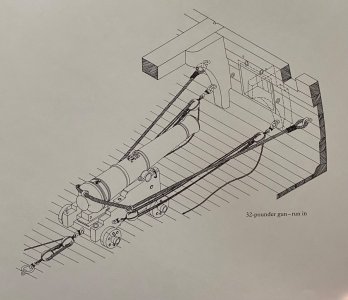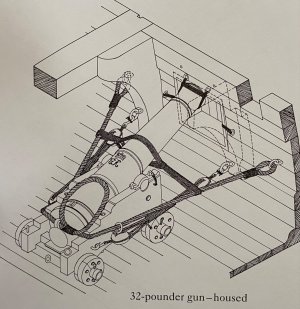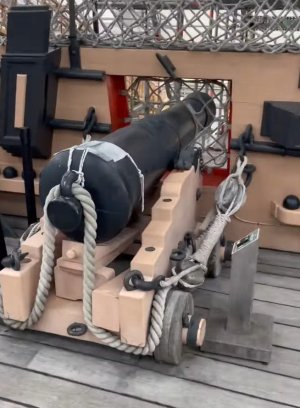-

Win a Free Custom Engraved Brass Coin!!!
As a way to introduce our brass coins to the community, we will raffle off a free coin during the month of August. Follow link ABOVE for instructions for entering.
You are using an out of date browser. It may not display this or other websites correctly.
You should upgrade or use an alternative browser.
You should upgrade or use an alternative browser.
The blocks are oversized and upside down so maybe not what you want to duplicate.
The following is from Adrian Caruana's The History of English Sea Ordnance Volume 2. His book is the most researched available for English guns and tackle.
In general guns under 32 pounder had train tackle with two single blocks. 32 pounders and heavier had a single and double on each side of the carriage. Each block was equipped with a hook. The same goes for the train tackle. The train tackle came into use in the early 18th century so would not be on earlier English ships.
Rope circumferences
The breech rope size varied with caliber and era. It was between 4 and 7 inches in circumference depending on caliber and era. The securing of the breech rope to the bulwark rings varied a lot with era as well.
The following chart is from the Sea Gunner's Vade Mecum 1812. It is limited by date but at our scales, a pretty good guide.
Allan
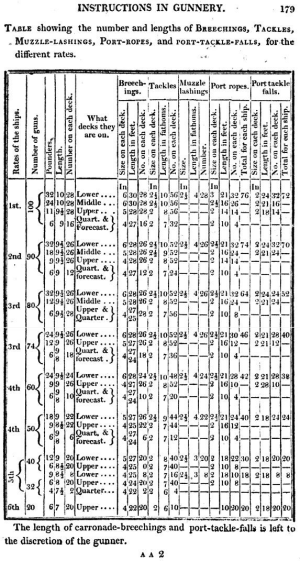
The blocks can be sized according to the rope diameter but it gets a little complex.
From David Steel, page 153 (the entire book can be found at https://maritime.org/doc/steel/
THE proportions for single, double, treble, fourfold, and other blocks, are as follow; viz. the length is 8 times the breadth of the sheave-hole, which is one-sixteenth of an inch more than the thickness of the sheave; the thickness of the sheave is one-tenth more than the diameter of the rope it is intended for, and the diameter of the sheave is five times the thickness. The breadth of the block to be six times the thickness of the sheave, and the thickness to be one half the length, or nearly so.
IF my math is correct for the 2.5" tackle rope the block would be about 7 1/4" long
For the 2" tackle the block would be about 5 3/4" long.
By the same token you can just take the circumference and multiply by 3 and you will be very close.
Allan
The following is from Adrian Caruana's The History of English Sea Ordnance Volume 2. His book is the most researched available for English guns and tackle.
In general guns under 32 pounder had train tackle with two single blocks. 32 pounders and heavier had a single and double on each side of the carriage. Each block was equipped with a hook. The same goes for the train tackle. The train tackle came into use in the early 18th century so would not be on earlier English ships.
Rope circumferences
The breech rope size varied with caliber and era. It was between 4 and 7 inches in circumference depending on caliber and era. The securing of the breech rope to the bulwark rings varied a lot with era as well.
The following chart is from the Sea Gunner's Vade Mecum 1812. It is limited by date but at our scales, a pretty good guide.
Allan

The blocks can be sized according to the rope diameter but it gets a little complex.
From David Steel, page 153 (the entire book can be found at https://maritime.org/doc/steel/
THE proportions for single, double, treble, fourfold, and other blocks, are as follow; viz. the length is 8 times the breadth of the sheave-hole, which is one-sixteenth of an inch more than the thickness of the sheave; the thickness of the sheave is one-tenth more than the diameter of the rope it is intended for, and the diameter of the sheave is five times the thickness. The breadth of the block to be six times the thickness of the sheave, and the thickness to be one half the length, or nearly so.
IF my math is correct for the 2.5" tackle rope the block would be about 7 1/4" long
For the 2" tackle the block would be about 5 3/4" long.
By the same token you can just take the circumference and multiply by 3 and you will be very close.
Allan
Thank you for the wonderfully informative reply. Any idea for the Fair American model, since it is shown with 14 guns. What rate would they have considered this to be?
I have Dr. Clayton Feldman's Progressive Scratch-Building in Ship Modeling paperback book. But, the pictures are not very clear or in color. Is there another copy of this book anywhere that has clear colored photos?
I have Dr. Clayton Feldman's Progressive Scratch-Building in Ship Modeling paperback book. But, the pictures are not very clear or in color. Is there another copy of this book anywhere that has clear colored photos?
Here is a wonderful video from Olha Batchvarov showing her rigging the cannons for a ship. Well worth watching!
Rob
Rob
when it comes to rigging guns, just about all kits get the block size wrong.
Going by the sample photo, the blocks used on that gun would be the correct size block to hoist the main yards with.
As for Fair American, that ship has discrepencies. Most of the time based onthe existing modelsS, plural, the ship had either 12 or 14 guns.
if rigged with 14 guns as shown in the model shipways kit, everyone complains that the rear most guns are essentially rubbing on the after deck wall. As in, the guys pulling the stern most tackle, would have to stand on the wheel.
Going by the sample photo, the blocks used on that gun would be the correct size block to hoist the main yards with.
As for Fair American, that ship has discrepencies. Most of the time based onthe existing modelsS, plural, the ship had either 12 or 14 guns.
if rigged with 14 guns as shown in the model shipways kit, everyone complains that the rear most guns are essentially rubbing on the after deck wall. As in, the guys pulling the stern most tackle, would have to stand on the wheel.
I would like her to have some commentary on what she is doing during the video. Maybe some typed commentary.Here is a wonderful video from Olha Batchvarov showing her rigging the cannons for a ship. Well worth watching!
Rob
Hi YTSpare the science this is how Victory cannons were rigged.
This is not really science, it is merely given as contemporary information on how things were done for anyone that might interested. If it is information overload, my sincere apologies. The rigging of the breeching in the video and the drawings you posted are not like those used on British ships. Up to 1750 the breeching was secured to the ring by a round turn and two half hitches. From that point to 1790 there was the turn and single half hitch. From the Science Museum in London, by 1790 a thimble was inserted in the wrought iron ring and the breeching had a small seizing at the throat and subsequently knotted. In the end, the model builder can do what they want, just wanted to offer up alternative information based on contemporary sources for those that might find it interesting.
Allan
The gun tackles are one feature ship modelers always strive to have on their models if they are 1:72 scale or larger, but in all cases, the blocks are too large. This gun below has 1.5mm blocks used in the gun tackles on a 1:78 scale model, and the blocks are still too large. These blocks are the smallest ones I can find, and are occasionally available at Dry-Dock Model Ships & Parts. When Zoly has these in stock, I usually buy most of his inventory. They are difficult to rig because of their size, but after doing 264 tackles using them so far, I'm getting pretty good at it. See how the breeching lines are hanging down over the trucks and rings in nice loops? You have to glue the lines to the truck wheels and deck in small spots with CA glue, and apply some diluted PVA glue to segments of the line to form them in order to get them to drape realistically. This is often not done by modelers, and it ruins the immersion and illusion of realism. The eyelets and hooks which fasten the gun tackles to the carriage and bulwark can be obtained at HiS Model in Czech Republic. Rigging tiny gun carriages at this level of detail is still more interesting and requires less patience than ratlining shrouds...
Demi-culverin drake on HMS Sovereign of the Seas. Note the half trucks used specific to this ship, with skids on the rear of the carriage instead of trucks. This was to increase the maximum elevation of the gun.
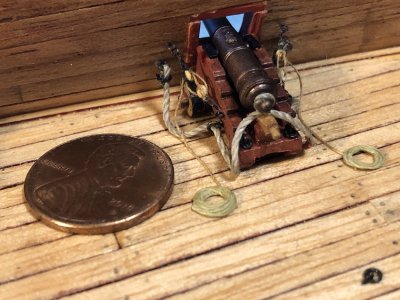
Demi-culverin drake on HMS Sovereign of the Seas. Note the half trucks used specific to this ship, with skids on the rear of the carriage instead of trucks. This was to increase the maximum elevation of the gun.

Last edited:
That gun on Victory is larger than drake on the Sovereign so the blocks on the Sovereign should still be a little smaller. If you can get close to your photo above, you're doing great.
Last edited:
Does this look accurate to you?
I think it may be wrong as the running out tackles are secured to the train tackle eyebolts at the rear of the carriage. One example based on a drawing in the Sea Gunners Vade Mecum below. Perhaps some ships had the running out rigging hooked to the train tackle eye when secured. Keep in mind the photo is modern day and may not be consistent with past practice, but there seems to have been inconsistencies from ship to ship in the days of sail, especially rigging practices.
Allan
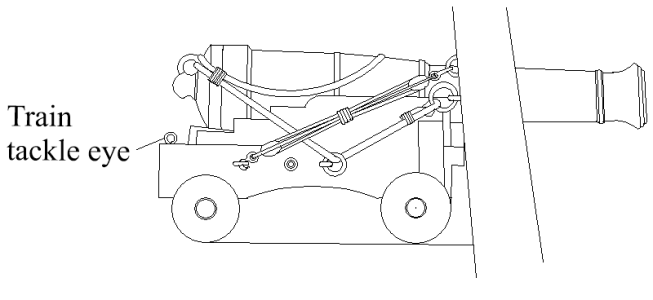
Exactly, Allen. Good eye there!I think it may be wrong as the running out tackles are secured to the train tackle eyebolts at the rear of the carriage. One example based on a drawing in the Sea Gunners Vade Mecum below. Perhaps some ships had the running out rigging hooked to the train tackle eye when secured. Keep in mind the photo is modern day and may not be consistent with past practice, but there seems to have been inconsistencies from ship to ship in the days of sail, especially rigging practices.
Allan
View attachment 514808
Does anyone here show or have seen a 6 Pounder cannon being fully rigged at 1/4" scale 1:48?
The parts are so tiny I am not sure that I have the eyesight to do it justice. But, I really want it to look good and as correct as possible.
The parts are so tiny I am not sure that I have the eyesight to do it justice. But, I really want it to look good and as correct as possible.
The smallest fully rigged gun I was able to achieve is a 9 pounder at 1:100 scale.
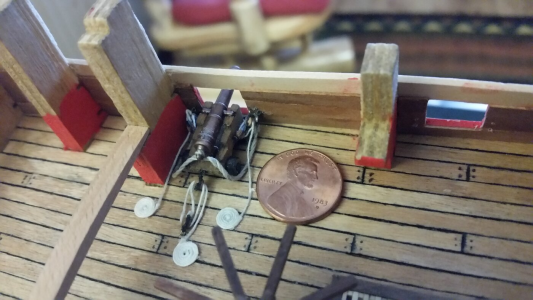
This had to be done by rigging the barrels and breeching lines first, then slipping the gun tackle rigged carriages under the barrels and gluing the eyebolts of those gun tackles to the bulwark as the final step. The use of hooks had to be abandoned, and eyelets were tied to blocks using black sewing thread.

Everything was accomplished using an eye magnification headset and careful tweezer work using CA glue and pre-drilled holes in the bulwarks. Even so, it is delicate, and it is difficult not to tear a a gun tackle apart or crunch something.
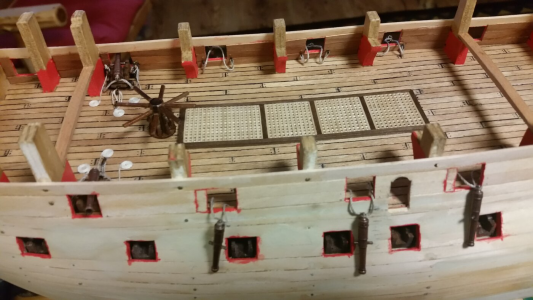
The four 6 pound sakers shown at the forecastle bulkhead proved too small to allow making of gun tackles at 1:100 scale, and the carriages had to be scratch built. It may be possible to create simulated blocks using globs of glue approximately 0.5mm in diameter onto thread in micro gun tackle assemblies, but since these sakers were covered by the upper forecastle deck anyway, that attempt was abandoned. Personnally, rigging cannon carriages is one of the more interesting and fun parts of a build.

An idea occurred to me. If the gun tackles were to be displayed in storage configuration as shown in @jbradford's photo below, perhaps the blocks could be simulated using tiny glass beads, the ones usually used in making simulated parrel trucks, and some thin thread? HiS Model in Czech Republic sells very tiny etched brass eyelets which could be used in the tiny gun tackles.

Brown glass beads used in making parrels
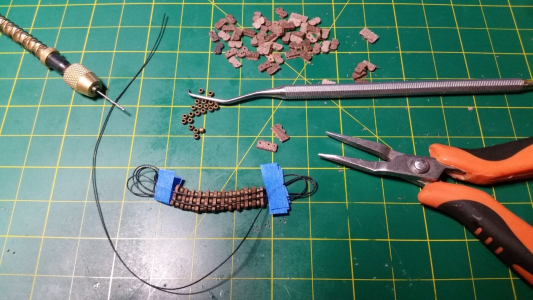

This had to be done by rigging the barrels and breeching lines first, then slipping the gun tackle rigged carriages under the barrels and gluing the eyebolts of those gun tackles to the bulwark as the final step. The use of hooks had to be abandoned, and eyelets were tied to blocks using black sewing thread.

Everything was accomplished using an eye magnification headset and careful tweezer work using CA glue and pre-drilled holes in the bulwarks. Even so, it is delicate, and it is difficult not to tear a a gun tackle apart or crunch something.

The four 6 pound sakers shown at the forecastle bulkhead proved too small to allow making of gun tackles at 1:100 scale, and the carriages had to be scratch built. It may be possible to create simulated blocks using globs of glue approximately 0.5mm in diameter onto thread in micro gun tackle assemblies, but since these sakers were covered by the upper forecastle deck anyway, that attempt was abandoned. Personnally, rigging cannon carriages is one of the more interesting and fun parts of a build.

An idea occurred to me. If the gun tackles were to be displayed in storage configuration as shown in @jbradford's photo below, perhaps the blocks could be simulated using tiny glass beads, the ones usually used in making simulated parrel trucks, and some thin thread? HiS Model in Czech Republic sells very tiny etched brass eyelets which could be used in the tiny gun tackles.

Brown glass beads used in making parrels

Last edited:
Success to you!Thank you for this. I may try 1 carriage tackle to see how it goes.
- Joined
- Feb 21, 2020
- Messages
- 103
- Points
- 58

You cannot imagine how helpful this discussion is. Thanks, Billy Grimball





